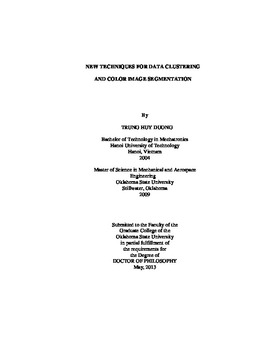| dc.contributor.advisor | Hoberock, Lawrence L. | |
| dc.contributor.author | Trung, Duong H. | |
| dc.date.accessioned | 2015-06-17T20:08:18Z | |
| dc.date.available | 2015-06-17T20:08:18Z | |
| dc.date.issued | 2013-05 | |
| dc.identifier.uri | https://hdl.handle.net/11244/15152 | |
| dc.description.abstract | The objectives of this work are twofold: (1) to create an improved automatic clustering procedure that produces results consistent with manual clustering of data points by humans; and (2) to find an improved technique for automatic segmentation of images. First, we developed a clustering technique using an M-ART (Mahalanobis distance-based Adaptive Resonance Theory) neural network. The "vigilance" p in the M-ART network affects the maximum size of clusters, and consequently affects the number of clusters. Normally the "optimal" value of p is heavily data dependent and therefore can only be chosen by users and adjusted by trial-and-error. We propose a procedure to automatically adjust the value of p based on a pre-defined required separation between clusters, which is data independent and can be determined beforehand. Experiments conducted on synthetic multidimensional and texture datasets demonstrate the effectiveness and reliability of the proposed method. Segmentation is the process of partitioning a digital image into multiple segments or non-overlapping regions. Partitioning an image into non-overlapping regions assures that pixels in each region share the same visual properties, such as color or texture, while pixels in different regions exhibit significant differences in these features. We found that M-ART works well only with convex-shaped clusters (segments) that are sufficiently separated, which is not the case for typical real-scene images. Accordingly, we investigated and presented developing a more advanced general purpose image segmentation method, called the DUHO method. This DUHO algorithm contains two main steps. First, the superpixel generating algorithm is applied to a given image to build K superpixels. Then a new region growing algorithm iteratively groups these superpixels into appropriate regions and forms the final image segmentation result. The proposed method is a type of unseeded region-based segmentation that preserves the spatial relationship between pixels in the image, and hence preserves the detailed edges and the image spatial structure. A quantitative evaluation method based on square color error is introduced, and experiments with real datasets, consisting of 300 color images of natural scenes from the available data, show very good results from our DUHO method when compared with results from the well-known segmentation methods. | |
| dc.format | application/pdf | |
| dc.language | en_US | |
| dc.rights | Copyright is held by the author who has granted the Oklahoma State University Library the non-exclusive right to share this material in its institutional repository. Contact Digital Library Services at lib-dls@okstate.edu or 405-744-9161 for the permission policy on the use, reproduction or distribution of this material. | |
| dc.title | New techniques for data clustering and color image segmentation | |
| dc.contributor.committeeMember | Hanan, Jay C. | |
| dc.contributor.committeeMember | Young, Gary E. | |
| dc.contributor.committeeMember | Fan, Guoliang | |
| osu.filename | Trung_okstate_0664D_12680.pdf | |
| osu.accesstype | Open Access | |
| dc.type.genre | Dissertation | |
| dc.type.material | Text | |
| dc.subject.keywords | adaptive region growing | |
| dc.subject.keywords | auto adjust vigilance | |
| dc.subject.keywords | automatic color image segmentation | |
| dc.subject.keywords | automatic data clustering | |
| dc.subject.keywords | m-art | |
| dc.subject.keywords | superpixels | |
| thesis.degree.discipline | Mechanical and Aerospace Engineering | |
| thesis.degree.grantor | Oklahoma State University | |
